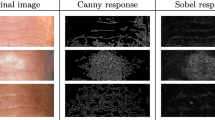Abstract
The convergence of information and medical technologies has resulted in the emergence and active development of the ubiquitous healthcare (U-Healthcare) industry. The U-healthcare industry provides telepathology and anytime-anywhere wellness services. The main purpose of these wellness services is to provide health information to improve the quality of life. Human skin is an organ that can be easily examined without expensive devices. In addition, there has recently been rapidly increasing interest in skin care products, resulting in a concomitant increase in their consumption. In this paper, we propose a new scheme for a self-diagnostic application that can estimate the actual age of the skin on the basis of the features on a skin image. In accordance with dermatologists’ suggestions, we examined the length, width, depth, and other cell features of skin wrinkles to evaluate skin age. Using our highly developed image processing method, we could glean detailed information from the surface of the skin. Our scheme uses the extracted information as features to train a support vector machine (SVM) and evaluates the age of a subject’s skin. Evaluation of our proposed scheme showed that it was more than 90% accurate in the analysis of the skin age of three different parts of the body: the face, neck, and hands. Therefore, we believe our model can be used as a standard or as a scale to measure the degree of damage or the aging process of the skin. This scheme is implemented into our Self-Diagnostic Total Skin Care system, and the information obtained from this system can be utilized in various areas of medicine.


















Similar content being viewed by others
References
Akazaka S, Nakagawa H, Kazama H, Osanai O, Kawai M, Takema Y, Imokawa G (2002) Age-related changes in skin wrinkles assessed by a novel three-dimensional morphometric analysis. Br J Dermatol 147:689–695
Beucher S, Lantuejoul C, (1979) “Use of Watersheds watersheds in contour detection,”. In procProc. International Int’l workshop on image processing, Real-time edge and motion detection/estimation
Boyer G, Laquièze L, Le Bot A, Laquièze S, Zahouani H (2009) Dynamic indentation on human skin in vivo: ageing Ageing effects. Skin Research and Technology 15:55–67
Choi Y, Kim K, Hwang E (2008) WASUP: A wrinkle analysis A using microscopic skin image. In Proceedings of Int’l Conference on Ubiquitous Information Technologies & Applications
Christopher JC, Burges CJC (1998) A tutorial on Support Vector Machines for Pattern Recognition. Data Mining and Knowledge Discovery 2:121–167
Edwards C, Heggie R, Marks R (2003) A study of difference in surface roughness between sun-exposed and unexposed skin with age. Photodermatol Photoimmunol Photomed 19:169–174
EmguCV: cross Cross platform .Net wrapper to the OpenCV, http://www.emgu.com/wiki
Fischer TW, Wigger-Alberti W, Elsner P (1999) Direct and nondirect measurement techniques for analysis of skin surface topography. Skin Pharmacol Appl Skin Physiol 12:1–11
Fujimura T, Haketa K, Hotta M, Kitahara T (2007) Global and systematic demonstration for the practical usage of a direct in vivo measurement system to evaluate wrinkles. Int J Cosmet Sci 29:423–436
Ilive D, Hinnen U, Elsner P (1997) Skin roughness is negatively correlated to irritation with DMSO, but not with NaOH and SLS. Exp Dermatol 6:157–160
John Hatzis J (2004) The wrinkle and its measurement -: A skin surface profilometric method. Micron 35(3):201–219
Jun-Ichiro Hayashi J, Koshimizu H, Hata S. et al. (2003) “Age and Gender gender Estimation estimation Based based on Facial facial Image image Analysisanalysis,”. KES 2003,; LNAI 2774, : pp. 863–-869
Jun-Ichiro Hayashi J, Yasumoto M, Ito H, Koshimizu H et al (2002) Age and Gender gender Estimation estimation Based based on Wrinkle wrinkle Texture texture and Color color of Facial facial Imagesimages. Int Conf on Pattern Recognition 1:10405405–408
Kim K, Choi Y, Hwang E (2009) Wrinkle feature-based skin age estimation scheme. In Proceedings of Int’l Conference on Multimedia and Expo
Lagarde JM, Rouvrais C, Black D (2005) Topography and anisotropy of the skin surface with ageing. Skin Res Technol 11:110–119
Lagarde JM, Rouvrais C, Black D, Diridollou S, Gall Y (2001) Skin topography measurement by interference fringe projection: a A technical validation. Skin Res Technol 7:112–121
Leveque JL, Querleux B (2003) SkinChip, a new tool for investigating the skin surface in vivo. Skin Res Technol 9:343–347
LIBSVM – A Library for Support Vector Machine, http://www.csie.ntu.edu.tw/~cjlin/libsvm
Nita D, Mignot J, Chuard M, Sofa M (1998) 3-D profilometer using a CCD linear image sensor: application to skin surface topography measurement. Skin Res Technol 4:121–129
Purba MB, Kouruis-Blazos A, Wattanapenpaiboon N, Lukito W, Rothenberg E, Steen B, Wahlqvist ML (2001) Can skin wrinkling in a site that has received limited sun exposure be used as a marker of health status and biological age?, Age Ageing 30:227–234
Tanaka H, Nakagami G, Sanada H, Sari Y, Kobayashi H, Kishi K, Konya C, Tadaka EH, Tanaka et al (2008) Quantitative evaluation of elderly skin based on digital image analysis. Skin research and technology 14:192–200
Yaobin Zou Y, Song E, Jin R et al (2009) Age-dependent changes in skin surface assessed by a novel two-dimensional image analysis. Skin Research and Technology 15(4):399–406
Acknowledgments
This research was supported by Basic Science Research Program through the National Research Foundation of Korea (NRF) funded by the Ministry of Education, Science and Technology (2011-0026448) and the MKE (Ministry of Knowledge Economy), Korea, under the ITRC (Information Technology Research Center) support program supervised by the NIPA (National IT Industry Promotion Agency) (NIPA-2012- C1090-1201-0008).
Author information
Authors and Affiliations
Corresponding author
Rights and permissions
About this article
Cite this article
Choi, YH., Tak, YS., Rho, S. et al. Skin feature extraction and processing model for statistical skin age estimation. Multimed Tools Appl 64, 227–247 (2013). https://doi.org/10.1007/s11042-011-0987-7
Published:
Issue Date:
DOI: https://doi.org/10.1007/s11042-011-0987-7




